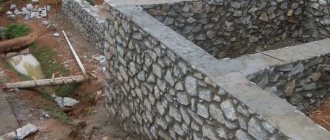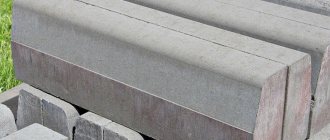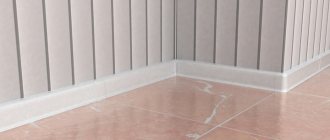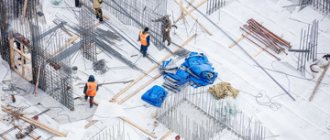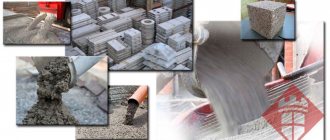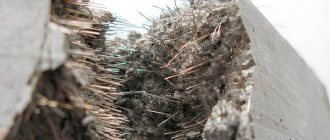A building material that is mined in quarries during the development of dolomite, sandstone, and limestone deposits is rubble stone, which has unique natural properties. There are many areas of application for buta; it differs in appearance and characteristics.
What is rubble stone?
Large cobblestones of irregular shape, up to 500 mm in size, better known as rubble stone, are used in construction. Essentially, these are rock fragments that are formed during explosive mining. All over the world there are ancient pavements laid out with the rounded appearance of rubble stone rolled in with water. It has been used for a long time, having appreciated the properties, visual appeal and durability of the material.
Application of rubble stone
Stones, characterized by irregular shapes and sizes, are widely used in construction. There are many types of rubble stone - this is a material obtained from the processing of rocks and is found in its original form in deposits and quarries. There are many areas of application for buta:
- dams, dikes, bridges over rivers and other hydraulic structures;
- landscape design, decorative finishing of individual garden elements and buildings;
- dry masonry of walls, foundations, fences.
PRICE FOR RUBBLE STONE
| NAME | FRACTION | PRICE WITH DELIVERY FOR 1M3 |
| RUBBLE STONE | 70-150 | from 3100 rub. |
| RUBBLE STONE | 70-250 | from 3100 rub. |
| RUBBLE STONE | 70-300 | from 3100 rub. |
Characteristics of rubble stone
It is easy to distinguish rubble stone from other rocks: it has an uneven shape and differs in size. Certain requirements for this building material:
- The size of one decorative stone should be no more than 50 cm, and the weight should not exceed 50 kg. Industrial stone has a permissible size of 30 cm and a weight of 30 kg.
- The permitted content of impurities in buta is 2% or less. The density of rubble stone should be 1800 kg/m³ and higher.
- A high-quality rubble should not have cracks, clay or delamination. You can determine the uniformity of the stone by hitting it with a hammer. Clear and not dull sound guarantees good quality.
- Rubble stone is characterized by a strength grade that varies from M100 to M1400.
- Frost resistance of eco-stone is an important parameter, which is achieved through several cycles of freezing and thawing. The minimum number of such cycles is 15. Natural rubble stone with values F300-F400 is considered the most frost-resistant.
- The radioactivity of rubble for residential buildings should not exceed 370 Bq/kg, this is the maximum value for the first class. Industrial stone can be used with values greater than 370 Bq/kg, this is the second safety class.
What is a boot?
Rubble stone is irregularly shaped rock fragments. The diameter of such pieces is usually 25-50 cm, and the weight is no more than 50 kg. As a rule, rubble stone is obtained from fairly strong sedimentary rocks, the density of which exceeds 1800 kg/m3. Most often it is limestone, sandstone or dolomite (less often - tuff, diorite or shell rock).
Rubble used for construction purposes must not have any cracks or delaminations. In addition, its “purity” is also extremely important (the amount of clay or marl impurities in the rock should not exceed 2%). By the way, the purity of the bottle is determined by the tonality of the sound. The clearer and smoother a stone sounds when struck with a hammer, the more uniform its structure.
So-called beds, decorative slabs and panels are made from rubble. Rubble stone is also processed into crushed stone.
Types of rubble stone
Eco-friendliness and durability are features of buildings made from natural cobblestones. A house made of rubble stone will last for decades and will meet its descendants with dignity. The main disadvantage of this material is the labor intensity during construction and the difficulty of transportation. Otherwise, natural eco-stone has only advantages. By type, this material can be divided into several types, differing in size and purpose:
- industrial;
- decorative;
- rounded;
- bedded.
Industrial rubble stone
As a building material, rubble is widely used in industry. Such stone is mined in mines and quarries, and then processed in crushing plants. Understanding that this is rubble stone for industrial purposes, it is easy to determine in what areas it can be used, so the following can be made from it:
- hydraulic engineering facilities – dams and dikes;
- top road surface;
- foundations of large objects;
- bridges;
- crushed stone
Decorative rubble stone
Rubble is extracted manually, which is used in the decoration and design of park areas. Knowing what rubble stone is, what it looks like and what properties it has, you can imagine how long the objects built with its help will last. An environmentally friendly and durable material can be used in the construction of garden landscape design elements:
- The base made of rubble stone will last for centuries.
- Natural materials can be used to line fountains, lay out borders, and decorate flower beds.
- It is recommended to use rubble to cover garden paths, which can last a long time and are not afraid of temperature changes and other external factors.
- A fence made of rubble stone, laid by experienced specialists and deliberately aged, can become a spectacular element decorating any area.
- Stone can be used to lay the walls of a house, garage or courtyard buildings.
Rounded rubble stone
Natural round-shaped rubble stone acquires its unique shape due to the influence of natural factors, it is ground by reservoirs, and it rolls down cliffs. This material has no sharp corners; stones of this type have impressive sizes and irregular shapes; designers like to use them in a variety of buildings:
- A retaining wall made of rubble stone will last for centuries, is able to maintain its appearance and not lose its functions.
- Gabions filled with rounded rubble look attractive.
- Paths and fences made of this type of material will decorate any garden plot.
Layered rubble stone
A stone that has two parallel planes is called bedded. This type of rubble is easy to use, it is easy to lay, it requires a little solution, and you can work with it quickly. The use of this type of rubble stone is based on its decorative properties; it produces spectacular elements for garden decor:
- alpine slides;
- decorative walls and fences;
- artificial reservoirs;
- swimming pools.
Advantages and disadvantages of a rubble stone foundation
The strengths of a rubble stone foundation include:
- Wear resistance and long service life. A building with such a foundation will last at least 80 years. As practice shows, most often this period exceeds 100 years.
- Resistant to high or low temperatures and moisture. Rubble stone is suitable for use in any climate zone.
- No need for external finishing. The stone has an attractive appearance even without it.
At the same time, the disadvantages of a rubble stone foundation should be highlighted:
- This material varies greatly in size, weight and shape, so it is more difficult to work with it than with the same brick. It takes a lot of time to sort the stone, and the laying itself is quite labor-intensive.
- To install the foundation, a trench is required with a depth below the freezing point of the soil. This means that the volume of excavation work is quite large.
- The rubble foundation is the longest in terms of construction time.
How to use rubble stone?
Rubble stone structures last for more than two hundred years. Foundations made from natural cobblestones retain their shape perfectly, they are not afraid of groundwater, and they do not lose their quality in severe frosts. Paths made of rubble stone can last a long time and are not exposed to external factors. Environmentally friendly rock fragments can be used for construction:
- fences;
- fencing;
- foundation;
- flower beds;
- borders;
- dams;
- bridges.
Rubble stone solution
To lay heavy rubble stone, you need a special solution that does not spread on the surface and is capable of maintaining its shape. It is easy to prepare a mixture for laying a rubble stone foundation: you need to take one part M400 cement and three parts sand. Stones are installed on such a hard cement-sand mixture; if their back surface collapses, it is necessary to place small stones. You cannot rush in the process of laying rubble; each next row is laid out after the previous one is well established.
Rubble stone masonry
It is possible even for an inexperienced craftsman to lay out irregularly shaped stones into a smooth vertical surface, he just has to put in a little effort and diligence. Laying rubble stone with your own hands is a labor-intensive process that requires the help of relatives or experienced specialists. To lay a foundation, basement or plinth from rubble stone, you should proceed in stages:
- Sort the stone by laying it out into several piles: put the largest stones in the first, those whose length corresponds to the width of the wall in the second, stones with right angles in the third, and the rest in the fourth.
- The bottom rows are formed from the largest stones; rubble from the third pile should be placed in the corners.
- During the laying process, it is necessary to show imagination, trying to join cobblestones of different shapes, trying to maintain the evenness of the rows.
- Fractures and edges of stones are leveled using mortar.
Main characteristics of the stone
For the production of rubble stone, rocks with a density of at least 1800 kg/m³ are used. The size of the fraction of the materials used is most often in the range from 15 to 50 cm. However, at the customer’s request, it is quite possible to supply both smaller (from 70 mm) and larger (up to 1000 mm) fractions. According to technical requirements, rubble stone can contain no more than 2% (of the total mass of the material) of various impurities. High-quality material should not contain any layers of clay , marl and similar impurities. The main rock should not exfoliate or have cracks.
The main technical parameters characterizing the quality of rubble are its strength and frost resistance . Strength qualities are characterized by tensile strength, which is measured in a laboratory (by compressing the original rock in a moisture-saturated state) using special measuring equipment.
Depending on what rock was used for production (light, heavy sedimentary, igneous), the strength of rubble varies in the range from 2 to 30 MPa, and it is divided into grades from 100 to 1200 (up to 400 in increments of 100, from 400 - in increments of 200). Material of metamorphic origin must have a strength of at least 400 and at least 600 from igneous origin.
Frost resistance of the material is at least 15 cycles . That is, the bottle was subjected to freezing and thawing at least 15 times and after that it does not crumble, does not flake and has not lost more than 5% of the total weight. Based on this indicator, manufacturers produce the following grades of rubble stone: F15, F25, F50, F100, F200, F300.
When struck with a hammer, a high-quality quarry “sings” in a clear voice. Dull sounds indicate that the material contains a high mass fraction of clay and other impurities. This material easily crumbles under impact loads.
How to visually age rubble stone?
It is possible to give natural stone an aged look using special techniques. Landscape designers use this technique to create flower beds, garden paths, design wells and decorative elements. Rubble stone for gabions - large cages filled with stones, used as partitions and fences, is also specially aged.
- The surface of the bottle must be rubbed with earth, and then treated with any food product containing bacteria - kefir, yogurt, beer. As a result, moss will appear on the stone, giving the old material a dilapidated appearance.
- Treating rubble with cow dung is a natural and inexpensive way of aging, thanks to which natural rubble stone will take on a mossy appearance.
- Durable rocks can be aged mechanically by creating a relief pattern on the surface using a special device.
- Using a gas torch, you can burn out the top layer of stone. With this method, the bottle will become aged and change color slightly.
Scope of application of rubble stone
Rubble is widely used in the construction industry. It is used for laying the foundation of monumental structures, engineering and hydraulic facilities. It is worth talking about rubble foundations separately, since modern technologies for constructing strip foundations require mandatory reinforcement. And only a foundation made of rubble does not need reinforcement, since the reinforcing frame itself becomes the pieces of rock of limestone, granite, shell rock with values not lower than 1000 kg/cm³.
When building a rubble foundation, it is important to follow several rules:
- the ratio of the rubble used and the concrete mixture should be 50/50;
- you should prefer a rubble with medium dimensions (≈ 20×30 cm); to be precise, the width of the stone should be about a third of the width of the supporting structure;
- the material must be as clean as possible, otherwise adhesion to the concrete mixture will be low;
- before installation, the rubble stone should be well moistened, which will minimize the loss of liquid from the concrete mixture and improve adhesion;
- the material must be strong enough (when hit with a hammer, the stone “sounds” loudly and clearly, does not split or crumble).
However, with all the positive qualities and characteristics of rubble, one must remember : it can be used for building a foundation only in those areas where the soil has normal density and does not subsidence. Rubble strip foundation is effective for low-rise construction if there is no need to build a basement.
Rubble masonry is successfully used in the construction of sewer canals, tanks, settling tanks, and buildings that will not subsequently be heated. For these types of work, the stone should not weigh more than 30 kg, so large pieces of rock are first split (using a sledgehammer, hammer or something else) into suitable sizes.
To build a small fence, you can use rubble without using a binding solution (dry masonry). For high structures and retaining wall construction, the use of concrete mixture becomes necessary . Rubble has been successfully used for cladding walls, fences, etc. There is a wide range of uses of this material in landscape design for the purpose of decorating a personal plot, building alpine slides, and cultivating personal ponds. Rubble stone, obtained from the most durable rocks, is successfully used in road construction for paving and lining squares and roadways.
Features of rubble stone masonry
Whatever the purpose for which the rubble is used, it is recommended to follow the following rules when performing installation work:
• before laying, it is necessary to create a solid foundation; it is made in a dug trench using a cushion of sand and crushed stone with careful compaction of the layers (the thickness of each layer is from 15 to 25 cm);
• before work, the stones are sorted by size, this will make the work easier and save a lot of time;
• the first rows are formed from densely laid stones and generous filling with a thin mortar; even the smallest voids must be filled with stones so that when freezing the foundation part is not damaged, the remaining rows are laid on a thick mortar (permissible layer up to 30 cm);
• milestone rows and corner elements are laid out from large rubble, its wide part is placed downwards;
• every 4th row of masonry is reinforced with reinforcing mesh or reinforcement rods.
Buildings on a rubble foundation are considered the most durable and reliable. And the decorative finishing of the facades will favorably distinguish the home from neighboring buildings.
